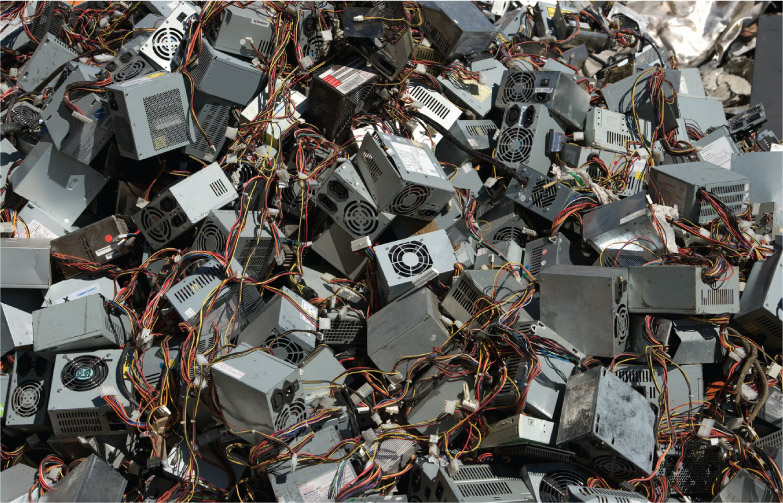7.3 Disposal of e-waste
Inappropriate disposal of ICT and other electronic goods creates significant environmental and social harm. Australians, as major consumers of electronic goods, need to be aware of their responsibilities in the disposal of these goods.
With a population of 23.5 million people (as of August 2014) Australia ranks just outside the top 50 nations in population size, but ranks in the top 10 nations in the purchase of electronic goods.
Currently more than 4 million computers and 3 million televisions are bought in Australia annually.
A big issue is that over 80% of our e-waste goes into landfill.
Less than 10% of these items are recycled. With the rapid increase in the purchase of electronic goods this problem will continue to grow unless we change our behaviour.

If half the televisions we discard were recycled, an estimated 23 000 tonnes of carbon dioxide emissions would be saved, equating to about 5300 cars off the road for an entire year.
DEVELOPING YOUR UNDERSTANDING 7.4
- Copy the table below and complete it by listing the reasons for and against each method of disposal of e-waste.

For Against Put in rubbish bin Sell Take to recycling centre Store at home - Read the following questions and conduct a class discussion on them:
- How are consumers of smartphones, tablets and other ICT devices contributing to human rights abuses and environmental damage in many parts of the world?
- What can we do to be more responsible in our purchase, use and disposal of ICT devices?
- Write a short essay (up to 250 words) explaining what the problems are and the actions you can take to reduce your environmental and human rights impact as a consumer and discarder of electronic goods.
Australian governments have been aware of e-waste problems for several years. One problem has been the dumping of e-waste in less developed countries in Asia or Africa. The e-waste was either just dumped in huge piles or crudely recycled. Toxic chemical wastes are exposed as the products break down and enter the waterways, soil and air.
In 1992 Australia signed the Basel Convention on the Control of Trans-boundary Movements of Hazardous Wastes. The agreement places a duty on countries that export waste to ensure that hazardous waste (including e-waste) is managed in an environmentally sound manner in the country that is receiving it.
In 2011 the Australian government established the National Television and Computer Recycling Scheme. The scheme involves a combination of government rules and industry action to take responsibility for the collection and recycling of waste televisions, computers, printers and computer products. The scheme is continually being improved, but electronic dumping still occurs.
Under the scheme, householders and small businesses can drop off these items free of charge at designated access points, which may include permanent collection sites, take-back events or through a mail-back option.
Source 7.6a This video was made to raise public awareness when the National Television and Computer Recycling Scheme was established in 2011. (02:46)
These are positive steps in responsible disposal of our electronic waste. However, there are still major problems.
An SBS Dateline report that aired on 25 September 2011 and titled ‘E-Waste Hell Ghana’ found that Australian e-waste was being exported to Ghana as working ‘second-hand products’, rather than as e-waste, to bypass the Basel Convention. It was then ‘recycled’ by the locals, including by burning wiring to extract the copper, which releases toxic smoke. People were living on or very near to the e-waste dumps. This still goes on in Ghana.
At the core of the problem for Australia is the sometimes be more than the cost of buying the product fact that the cost of recycling e-waste properly can in the first place.